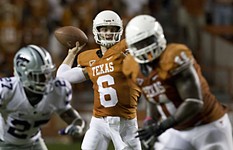The Hero Returns
Vince Young carves out a second career at UT-Austin
By Jessica Luther, Fri., Feb. 13, 2015
If you need to find Vince Young on the University of Texas campus these days, don't go to Darrell K. Royal-Texas Memorial Stadium. Instead, find the Flawn Academic Center (tucked between the Tower and the Union) and take the elevator to the fourth floor. There you'll find the offices of the university's Division of Diversity and Community Engagement (DDCE), and it's there that Young reports to work.
The DDCE's mission is simple: to encourage, create, and foster a diverse and multicultural campus at UT. But the division's umbrella is larger than that, and under it they serve children as young as pre-K, have relationships with high schools throughout the state, work to engage the Austin community at large, and help to expand the number of faculty of color. When one imagines where a legendary football hero will go when he returns home to the university and the city that loves him, it is most often to the green grass of the football field. It's probably not to under-resourced high schools that are primarily populated by students of color. But when it came time for Vince Young to choose his post-football work, he picked the latter. Here's why.
On a rainy, cold Saturday earlier this month, Young pulled his Texas-sized truck into the empty parking lot outside of Hargis Hall, the building topped with the intricately decorated cupola next to the Frank Erwin Center at the corner of MLK and I-35. Dressed in jeans, boots, and a sport coat, he entered the nearly deserted first floor. When he stepped off the elevator upstairs, you could hear the chatter of more than 100 excited high school students attending an annual UT "Outreach Austin" event. That's the DDCE initiative that, according to the website, "targets and serves underrepresented students by providing college readiness enrichment designed to assist them in graduating from high school and matriculating to institutions of higher education." Young often talks to the students involved in this program, sometimes traveling to the other UT Outreach locations in Dallas, Houston, San Antonio, and the Rio Grande Valley.
When Young entered the room, students elbowed each other and whispered excitedly. One student held up his iPad to snap a picture. Gregory Vincent, the vice president for the DDCE, says that when Young gets in a room with young people it is "magic" because "he resonates with them" and they are "captivated." Young says that he knows when they first interact with him, high school students think, "Wow, Vince, this big superstar guy that played football and did a lot of great things" – and so to make them more comfortable, "I go in there and take that ... cape off of the 'athlete Vince.'"
Young is comfortable in front of the kids. He immediately launches into the story of his own childhood and speaks candidly: "We [he and his two older sisters] were always at home by ourselves. My mom was strung out on drugs. I went through a lot as a young man." Later, while speaking about the necessity of hard work, he says that "even though my mom was out drinking and smoking and having a good time, she went to work every morning." In talking about the ripple effect of his own college degree, he says, "I was raised by women. The women in my family were true leaders." And now he leads them. His mother is back in school, and one of his sisters now has a real estate license.
Young tells the students he is proud of them, says he knows that things will be rough at times, and he encourages them to admit when they have difficulties and to lean on others. He speaks of his own mentors: the late NFL quarterback Steve McNair ("I used to look up to him every day"), his pastor, and his former Longhorn football coach, Mack Brown (whom Young calls "Mack Daddy," eliciting a laugh from the group). During the Q&A session, Young confesses that when he first got to UT-Austin, he didn't think he'd be able to keep up with his peers, "I had low self-esteem" – and credits his wife with mentoring him.
There is a final question. Kaliyah Martin, a 17-year-old from Round Rock's Cedar Ridge High School, asks Young, "How are you planning to or how have you already used your leverage, your athlete status to change this world?" Young tells her that's a good question, asks her name, and says, "You go, girl," before describing his current job at the DDCE. "What I'm doing right now with my job at the University of Texas: speaking to first-generation [college] kids about how to get to college and how to be successful."
The Athlete's Whirlwind
Most people who follow college football can recall the image of Vince Young standing in shotgun formation, taking the snap on the 9-yard-line in the 2006 Rose Bowl. On fourth down, with only 26 seconds to go, down by 5 points in the national championship game against the University of Southern California, Young looked for a moment as if he might try to pass left. Instead, he quickly sped to his right, running into the corner of the end zone. That now legendary sprint gave Texas the lead and (after 19 more seconds of play) the national championship, the school's first in 35 years. Young scored three touchdowns that game, passed for 267 yards, and logged 200 yards rushing. In short, it was one of the best individual performances in college football history.
Following that victory, Young entered the NFL draft, forgoing his senior year. He was the third overall pick in 2006, chosen by the Tennessee Titans. An inspired first season with Tennessee led to Young receiving the Rookie of the Year Award. But by the opening game of the 2008 season, Young was struggling, and had been often at odds with the Titans' head coach, Jeff Fisher. The day after that game, Fisher called the Nashville police and reported that Young could be suicidal.
It turned out that Young was fine. But the stigma of that episode, and rumors of Young's lack of preparedness on the field, stuck with him. He barely played in 2008, led the Titans on a valiant and unprecedented second-half of the season run in 2009, but after a losing 2010 season was released into free agency. He played one more year as a backup in Philadelphia, and for two more years tried, unsuccessfully, to sign with another team.
During his time in the NFL, Young got married, had three kids, returned to school and graduated with his bachelor's in education (the first in his family to graduate from college), invested in the Vince Young Steakhouse, started the Vince Young Foundation, spent time dealing with two lawsuits that involved people close to him and a loan taken out in his name, and he filed for Chapter 11 bankruptcy.
On June 15, 2014, Young announced his retirement from the NFL. His overall record was 31-19, but he had thrown more interceptions than touchdowns. Two months later, the University of Texas announced that Young had been hired as a development officer in the Division of Diversity and Community Engagement. Headlines splashed that he was getting paid a "six-figure salary" – technically true, precisely $100,000.
On the surface, the move from retirement into working for the university looked easy, even inevitable. But Young says that "the transition was tough. Very hard. To give up the game that you've been playing since you were a kid, and then trying to figure out what are you going to do." He had been in conversation with President Bill Powers for the last few years of his NFL career, trying to prepare for what he would do when it was time to stop playing ball. "When I was going through the transition from team to team," Young says, "I was telling [Powers], 'I want to be a part of the university, in any way I can.' He said some good ideas that he thought I would be a great fit for. The DDCE was the fit."
Why is the fit so good? Young answers simply, "I was the kid that we are supporting."
Knocking Down Walls
The Division of Diversity and Community Engagement was created in 2006, legend has it, after Powers and then-Vice Provost for Inclusion and Cross Cultural Effectiveness Gregory Vincent sketched it out on the back of a napkin. Vincent says the DDCE has a twofold mission. First, it's intended to "make the campus more inclusive for faculty, staff, and students" in order "to have a diverse campus that reflects the state." Second, the division helps "connect the resources of the university to the needs of the community," a mission beyond the Forty Acres and the 50,000 people on campus. From the successful legal defense of the university's admission policies that aim to create a multicultural campus, to the creation of two new departments – African & African Diaspora Studies and the Department of Mexican-American and Latina/o Studies – Vincent says that the impact of the DDCE has been wide-ranging.
"The campus is more diverse," he says, but quickly notes, "Certainly we haven't solved it. But what is clear is that we have made huge progress over these 10 years." On the community engagement side, Vincent says they "have 300 active partnerships with community-based organizations, which has led to a transformation to how communities feel about the university, particularly those residents in East Austin."
The division employs roughly 400 people (including employees of the UT charter school system and student workers), and it has a large menu of programs and services, among them the Gender and Sexuality Center, the Black Faculty and Staff Association, the Social Justice Institute, Indigenous Studies, and the University of Texas Elementary School. Vince Young, though an important figure, is one of many. He enjoys this part of the job, saying that one of his favorite aspects of his work is "interacting with the team [at DDCE], listening to the creativity we have around here."
Young's work at the DDCE falls into two categories: working with high school students in underserved populations, and fundraising for the programs that allow him to work with those students. Young says this is particularly fitting for him because "I used to be in the same shoes and position that these kids are in. I can help the awareness, not only for the kids, but from the parents' perspective of how to get to a great school like the University of Texas." One of the biggest problems for the population of students that he and the DDCE are trying to help is that many, if they attend college, will be the first in their family to ever do so. There's a knowledge gap there, Young says. "Some parents don't know [how to help their children] because they never went to college. So the kid cannot turn to his mom or dad, or whoever is in the household.
"A lot of kids hit that brick wall their senior year [of high school]," Young says. "'I've done everything I'm supposed to do in my grade, how do I get to college now?'" UT Outreach has the answer, and Young now serves as their messenger.
The division is honest about what Young brings to the table. Robiaun Charles, the associate vice president and executive director of development, is in charge of fundraising and philanthropy for the DDCE. She says that Young's impact has been "incredible and very positive." With his famous name, "he brings instant notoriety to the work we're doing." He is able, she says, to open doors "to individuals to hear the story to DDCE who might not understand the importance of it or might not readily respond." In other words, when it is Young calling, phones are answered more quickly. And while it is important, Charles says, that he can "provide access to broader audiences to potential supporters," his true worth is that he is able to speak "personally about why these programs are important to him" based on his own background.
Still, Young's new position is not without scrutiny. His $100,000 paycheck puts him well above the $50,000 average of UT employees, even above the $80,000 average for 20-year-veteran tenured professors. For this year, he's being paid from a special presidential account allocated directly by Powers; next year, the DDCE will officially assume the salary line. That amount, coming on the heels of Young's bankruptcy filing, and no hard data yet on his financial impact in this job, can evoke questions about the entire arrangement.
Tom Palaima, a professor in the Classics Department and an outspoken critic of major athletics at UT, says that there is also the issue of Young's educational preparation going into this high-paying position, and if he should be the one representing UT academics to aspiring future Longhorns. Palaima thinks it is "bad policy to tap into the glamour of a Vince Young as a sports star to sell youngsters on getting an education." Young, Palaima argues, is a quintessential example of how big-time athletics interferes with or hinders the educational aspirations of young athletes. Young's background is "not the kind ... we need in people championing changing the system. His hiring is just more of the same."
On the other hand, Kevin Robbins, senior lecturer in the UT School of Journalism and formerly* a sportswriter at the Austin American-Statesman, says that Young functions as a powerful symbol both on campus and throughout the state, of "what's possible at Texas." And the symbolism of Young, even if it functions primarily as a public relations move for the university or for the DDCE in particular, is being used to focus attention on a particular message and a particular group of students. While the university "could have had any make-work kind of job for him," Robbins says, instead "they found one that seems to have meaning. If someone is going to do this particular job at this particular school, he's probably the person to do it."
Patrick Patterson, assistant vice president of the Longhorn Center for School Partnerships, says it succinctly: "He opens up doors. He opens up doors for the DDCE, and we are going to open up as many doors as possible."
The Long Game
Young does still participate in the UT athletics program. "With the guys," he says, meaning the football players, "I go talk to them a lot." He also helps with recruitment ("girls' basketball, all sports," he notes) by "meet[ing] the parents, kind of giv[ing] them the perspective from the athletic side of it, how gracious and good [the athletic department] is, how much they support you." And you can see him as a commentator on the Longhorn Network. "I pretty much help the university, period," he says. "If they call or send a request form over here, need me to do anything, I try to be there for everybody."
Patterson says that his "goal for Vince is for people to know him as an educator, an academic, not so much the athlete." Patterson tells a story to illustrate his point. He was recently showing a high school student around campus, and when they visited one particular classroom, former Longhorn star and NFL running back Ricky Williams was a student in the class. "I walk the student up, have a conversation with Mr. Williams," Patterson says. It's only afterward that he realized the student didn't recognize Williams, other than as a UT student. Patterson laughs at the recollection. "One day, young people are not going to know that about Vince, not going to care that he was an athlete. They are going to know him as an educated man, conveying the story about how important an education is."
Young has goals of his own. Looking forward, he says he would like "to be on the Board of Regents." But "as a team goal" at the DDCE, "I'd like to raise as much money for the DDCE to help these kids and the programs that we have." No matter what, he sees himself at UT for the foreseeable future, "unless they tell me to get out of here," he jokes – a very unlikely turn of events.
At the end of his session with the students from UT Outreach Austin, Young asks them what they learned from his talk. The students shout out answers: "Believe in yourself!" "Don't be afraid to ask for help!" "Hard work pays off!" "Texas is the best!" So far, so good. The students are getting his message.
*Correction: This sentence originally identified Kevin Robbins as currently a Statesman sportswriter; he no longer works at the paper.
Got something to say on the subject? Send a letter to the editor.












